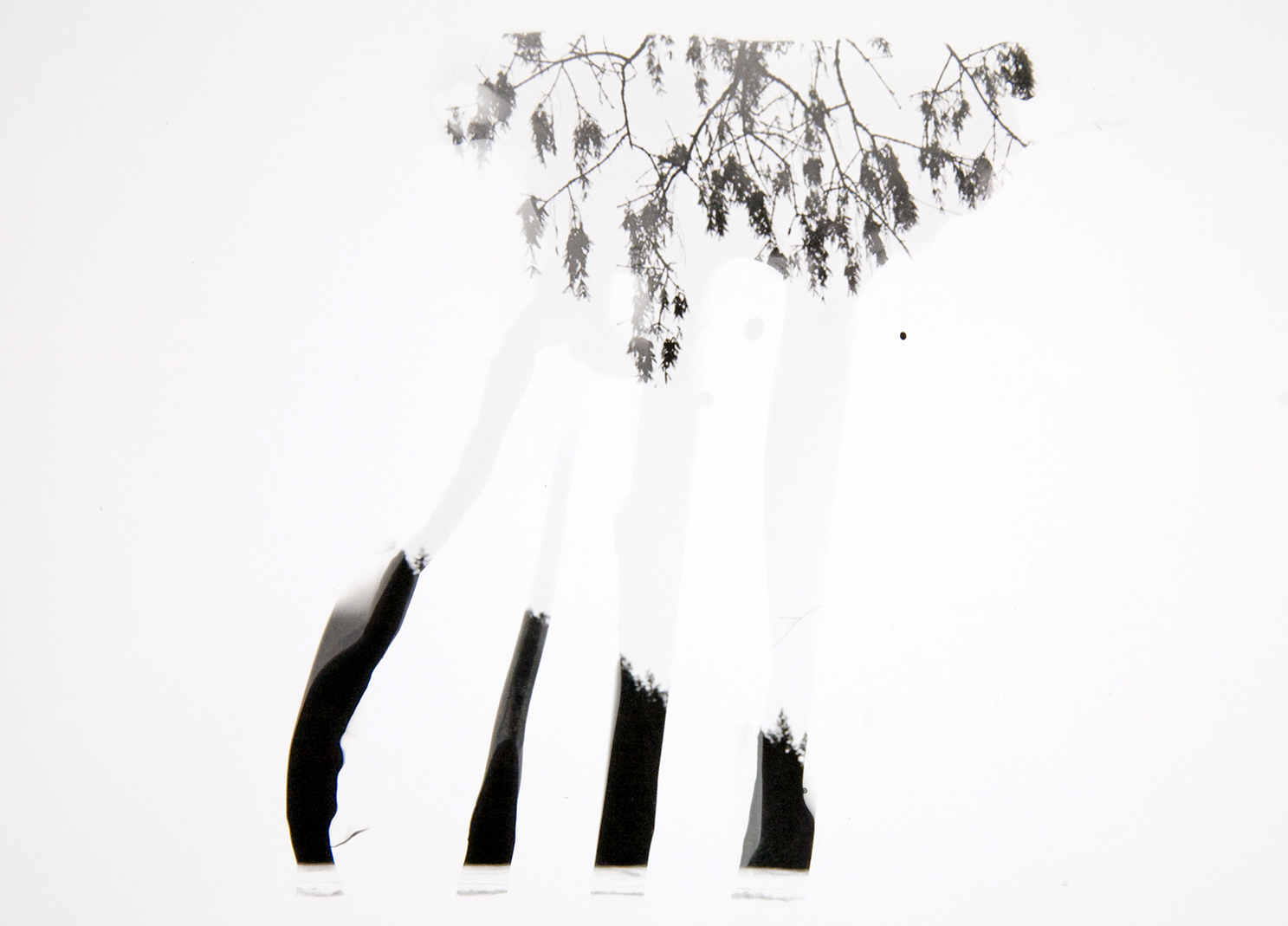Desert Experiments
Photography began as a scientific endeavor. The technology to focus light and form an image with a camera obscura and lens has existed since the beginning of the millennia. However, the technology to fix that image to a surface, to make it permanent, is a relatively new one. In the early 1800ʼs a scientific race began, culminating in the first photographic image by Joseph Niepce in 1827. Through Niepceʼs experiments with different chemical solutions, “writing with light” was invented. Later this idea was built upon by Louis Daguerre and William Henry Fox Talbot, both inventing their own chemical processes with which to photograph. Today, computer programs and digital cameras add a new layer of science and technology to photography, but the craft of literally writing with light is slowly becoming obsolete. This body of work is an experiment in the poetics of the chemical science of photography. Images of the landscape act as a backdrop for the chemical reactions. Printed in the darkroom, developer and fixer are painted onto photographic paper after a negative is exposed to chemically alter the image. The result is a composition based on the traditional chemical reactions of the photographic process –writing with light.

![Experiment [Great Salt Lake]](https://images.squarespace-cdn.com/content/v1/59bb3d16f43b55b15470e910/1558979555229-H1JOG40NN44VMM6NUWBX/01-Baczek-Experiment+copy.jpg)
![Experiment [Lightning Field]](https://images.squarespace-cdn.com/content/v1/59bb3d16f43b55b15470e910/1558979604654-E64WWI998BUHL7YJ72VE/Experiment-125.jpg)
![Experiment [Great Salt Lake]](https://images.squarespace-cdn.com/content/v1/59bb3d16f43b55b15470e910/1558979562389-6K3VLO0TCRA5R2IMOJX1/Experiment-58.jpg)
![Experiment [desert skeleton]](https://images.squarespace-cdn.com/content/v1/59bb3d16f43b55b15470e910/1558979570866-ZP1HVH5UDMKAPC0JQDAA/Experiment-83.jpg)
![Experiment [Lightning Field]](https://images.squarespace-cdn.com/content/v1/59bb3d16f43b55b15470e910/1558979600987-F55GU2S3EFAWLU79ASCV/Experiment-119.jpg)
![Experiment [Lightning Field]](https://images.squarespace-cdn.com/content/v1/59bb3d16f43b55b15470e910/1558979580430-QUCADJBB899XWQMV2GHF/Experiment-94.jpg)
![Experiment [Homeage to Moby Dick]](https://images.squarespace-cdn.com/content/v1/59bb3d16f43b55b15470e910/1558979607181-N2A7NCO9CL0OUMALGICL/Homage+to+Moby+Dick.jpg)
![Experiment [Great Salt Lake]](https://images.squarespace-cdn.com/content/v1/59bb3d16f43b55b15470e910/1558979557385-N5M9KB5KAKLM261K4O99/06-Baczek-Experiment.jpg)
![Experiment [Lightning Field]](https://images.squarespace-cdn.com/content/v1/59bb3d16f43b55b15470e910/1558979588553-2I1HBLEATRACEWUT1BWW/Experiment-100.jpg)
![Experiment [Great Salt Lake]](https://images.squarespace-cdn.com/content/v1/59bb3d16f43b55b15470e910/1558979566820-KF2FY51KAR4HNBICW2E8/Experiment-67.jpg)
![Experiment [Lightning Field]](https://images.squarespace-cdn.com/content/v1/59bb3d16f43b55b15470e910/1558979589723-NOTOSNBJD6W3OWLDVA0Q/Experiment-111.jpg)
![Experiment [desert skeleton]](https://images.squarespace-cdn.com/content/v1/59bb3d16f43b55b15470e910/1558979575960-YKZLO9JFUGV6CZS2Q0YS/Experiment-86.jpg)
![Experiment [Lightning Field]](https://images.squarespace-cdn.com/content/v1/59bb3d16f43b55b15470e910/1558979580042-2FJOXIUGG3RO193RR8SY/Experiment-96.jpg)
![Experiment [Great Salt Lake]](https://images.squarespace-cdn.com/content/v1/59bb3d16f43b55b15470e910/1558979557732-MTCU802PKK78Q3Z2EM7N/03-Baczek-Experiment.jpg)
![Experiment [Great Salt Lake]](https://images.squarespace-cdn.com/content/v1/59bb3d16f43b55b15470e910/1558979562515-VQRQPMBHMPJIOPWIRUSB/Experiment-62.jpg)
![Experiment [Lightning Field]](https://images.squarespace-cdn.com/content/v1/59bb3d16f43b55b15470e910/1558979603734-PRVLP8LHJ2TTNRVCIRED/Experiment-124.jpg)
![Experiment [Great Salt Lake]](https://images.squarespace-cdn.com/content/v1/59bb3d16f43b55b15470e910/1558979570518-VHVGMQJNC0K3ZTAB4D3O/Experiment-63.jpg)
![Experiment [Lightning Field]](https://images.squarespace-cdn.com/content/v1/59bb3d16f43b55b15470e910/1558979583956-3X20EXEP0H9A8AHPRHO9/Experiment-97.jpg)
![Experiment [Lightning Field]](https://images.squarespace-cdn.com/content/v1/59bb3d16f43b55b15470e910/1558979594055-5F7PNKHK07PFVMZVELB0/Experiment-112.jpg)
![Experiment [Great Salt Lake]](https://images.squarespace-cdn.com/content/v1/59bb3d16f43b55b15470e910/1558979555184-H1NU04XNUJ3CHGWGTI9F/02-Baczek-Experiment.jpg)
![Experiment [desert skeleton]](https://images.squarespace-cdn.com/content/v1/59bb3d16f43b55b15470e910/1558979576884-94P6ILV9D987GUYI671M/Experiment-88.jpg)
![Experiment [Lightning Field]](https://images.squarespace-cdn.com/content/v1/59bb3d16f43b55b15470e910/1558979598153-PSAZUNYPWG2LWS1KV64G/Experiment-118.jpg)
![Experiment [Lightning Field]](https://images.squarespace-cdn.com/content/v1/59bb3d16f43b55b15470e910/1558979596597-FKZE28ISNOHXOHOOLDBG/Experiment-115.jpg)

![Experiment [Lightning Field]](https://images.squarespace-cdn.com/content/v1/59bb3d16f43b55b15470e910/1558979584885-KJ2L03MN8DSE53VI8EQP/Experiment-99.jpg)